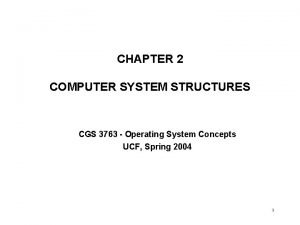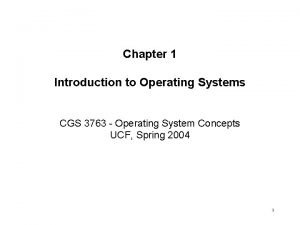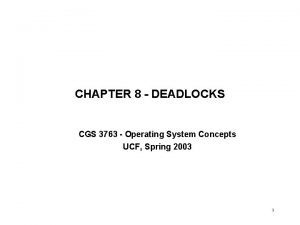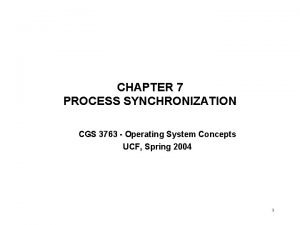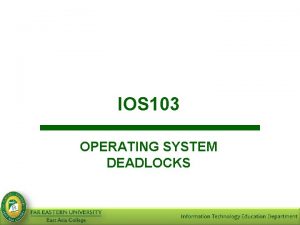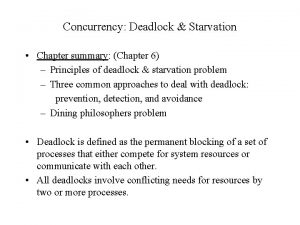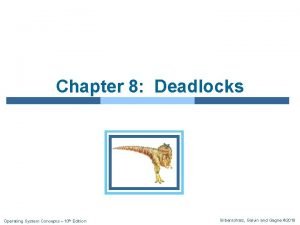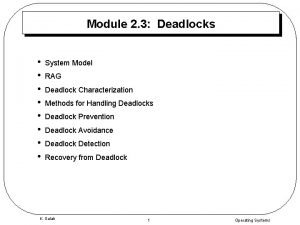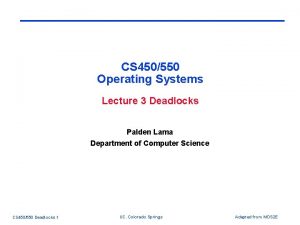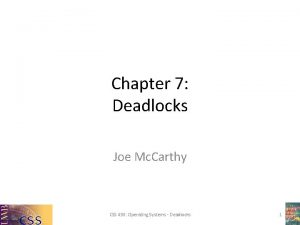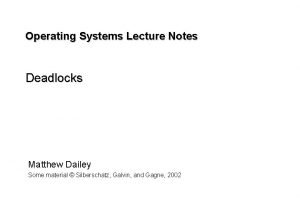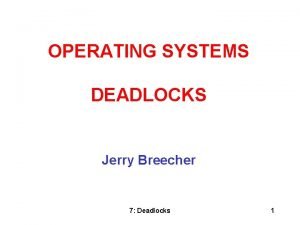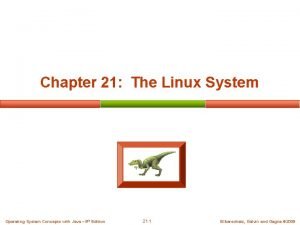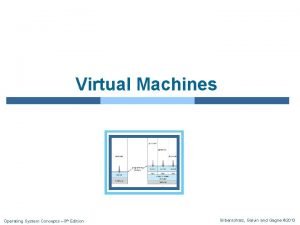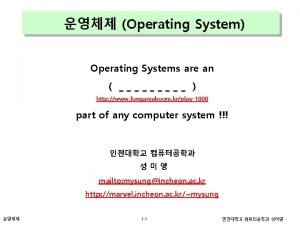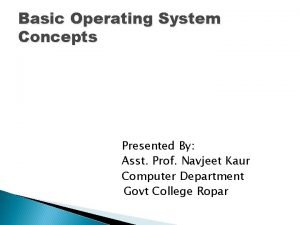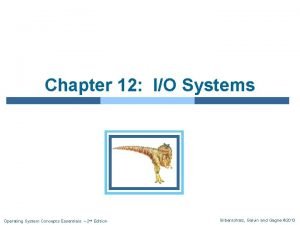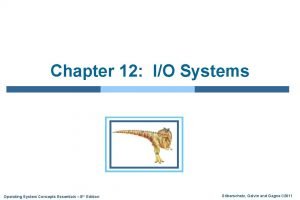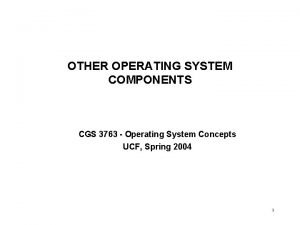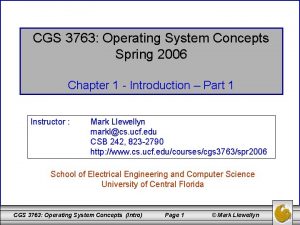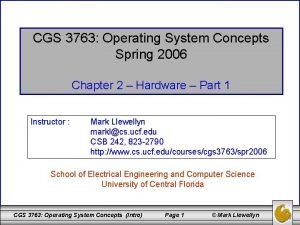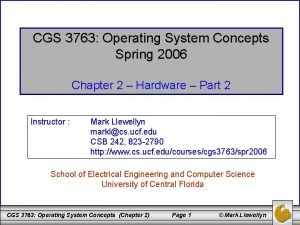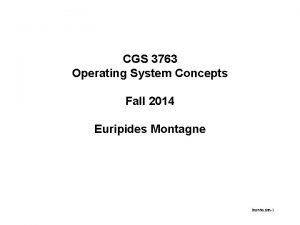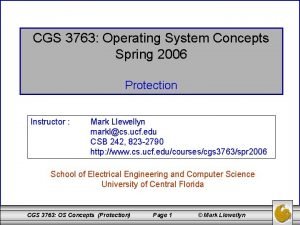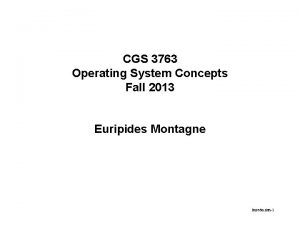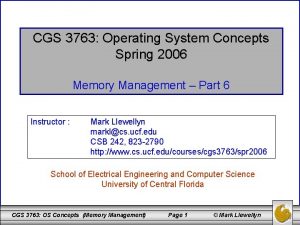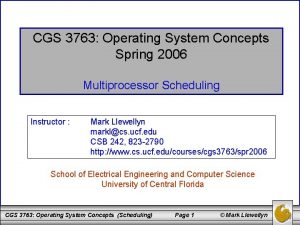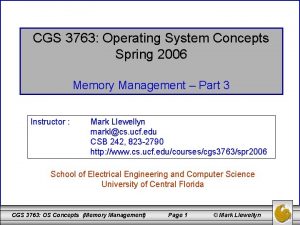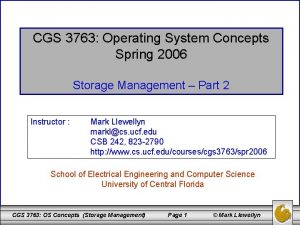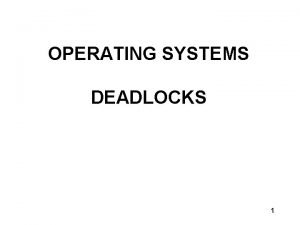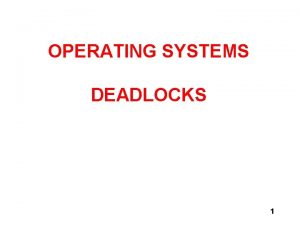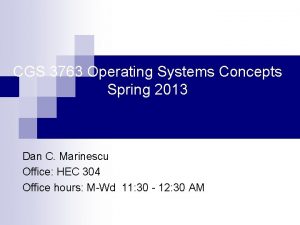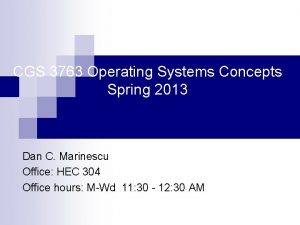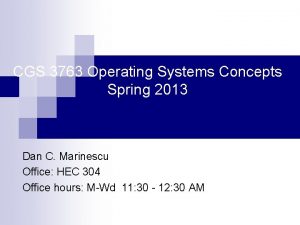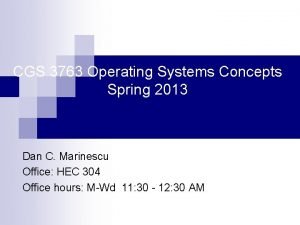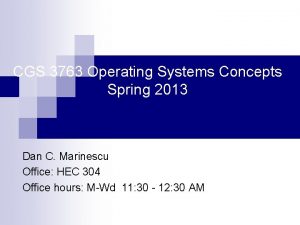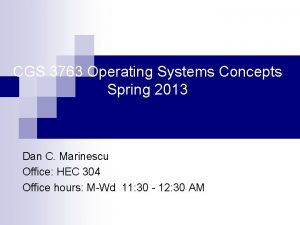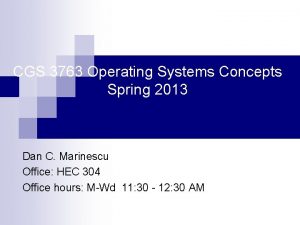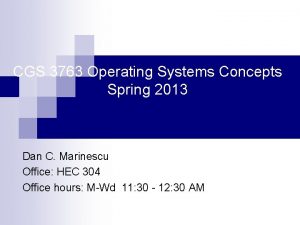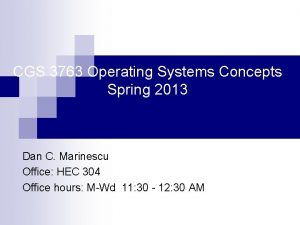CHAPTER 8 DEADLOCKS CGS 3763 Operating System Concepts


























- Slides: 26

CHAPTER 8 - DEADLOCKS CGS 3763 - Operating System Concepts UCF, Spring 2003 1

OVERVIEW • System Model • Deadlock Characterization • Methods for Handling Deadlocks – – Ignore Problem Completely Deadlock Prevention Deadlock Avoidance Deadlock Detection • Recovery from Deadlock • Combined Approach to Deadlock Handling 2

THE DEADLOCK PROBLEM • Occurs when a set of blocked processes are each holding a resource and waiting to acquire a resource held by another process in the set. • Example 1: – – System has 2 tape drives. P 1 and P 2 each hold one tape drive Each process needs another tape drive to continue. Sometimes referred to as “Deadly Embrace” 3

THE DEADLOCK PROBLEM (cont. ) • Example 2: – Programs with two critical sections referencing different variables A and B – Assume semaphores initialized to 1 Interrupt P 0 : P(A) P(B) A=A+1 B=B+1 V(B) V(A) : P 1 : P(B) P(A) A=A*B B=B+A V(A) V(B) : • Semaphores can solve critical section problem but can still allow starvation and deadlocks to occur. 4

SYSTEM MODEL • A system consists of a finite number of different resource types (e. g. , R 1, R 2, . . . , Rm). Examples of resources include: – Hardware - CPU time, memory, disks, I/O devices – Software - system programs (e. g. , Compilers, Editors), shared application programs – Data - variables, records, files • Each resource type Ri has Wi instances, Wi > 1. • Each process utilizes a resource as follows: – request resource – use resource – release resource 5

WHEN DOES DEADLOCK OCCUR? • Deadlock can arise if four conditions hold simultaneously: – Mutual exclusion: only one process at a time can use a resource. – Hold and wait: a process holding at least one resource is waiting to acquire additional resources held by other processes. – No preemption: a resource can be released only voluntarily by the process holding it, after that process has completed its task. – Circular wait: there exists a set {P 0, P 1, …, P 0} of waiting processes such that P 0 is waiting for a resource that is held by P 1, P 1 is waiting for a resource that is held by P 2, …, Pn– 1 is waiting for a resource that is held by Pn, and P 0 is waiting for a resource that is held by P 0. 6

RESOURCE ALLOCATION GRAPHS • Deadlocks can be represented using Resource Allocation Graphs: – A set of vertices V and a set of edges E – V is partitioned into vertices of two types: • P = {P 1, P 2, …, Pn}, the set consisting of all the processes in the system. • R = {R 1, R 2, …, Rm}, the set consisting of all resource types in the system. – request edge – directed edge P 1 Rj – assignment edge – directed edge Rj Pi 7

RESOURCE ALLOCATION GRAPHS (cont. ) • Process • Resource Type with 4 instances • Pi requests instance of Rj Pi Rj • Pi is holding an instance of Rj Pi Rj 8

EXAMPLE OF A RESOURCE ALLOCATION GRAPH 9

Resource Allocation Graph w/ Cycles and Deadlock 10

Resource Allocation Graph w/ Cycle But No Deadlock 11

WHAT DO CYCLES TELL US? • If resource allocation graph contains no cycles, then no deadlock can occur • If graph contains a cycle then, – if only one instance per resource type, then deadlock. – if several instances per resource type, possibility of deadlock. 12

METHODS FOR HANDLING DEADLOCKS • Prevention – Ensure that one or more of the four necessary conditions for deadlock never occur • Avoidance – Only allocate resources that keep system in safe state. Requires more info and decision with each allocation request • Detection & Recovery – Allow the system to enter a deadlock state and then recover. • Ignore the problem – Don’t do anything. Doesn’t happen that often and cost of avoidance or prevention very high 13

DEADLOCK PREVENTION • Prevent Mutual Exclusion: – Use sharable resources or virtual devices where possible • e. g. , print spooling, read-only files – Problem: Not always possible. Still must hold Hold non -sharable resources • e. g. , tape drives are intrinsically non-sharable 14

DEADLOCK PREVENTION (cont. ) • Prevent Hold and Wait: – Option A: Allocate all required resources at start of job (static) or – Option B: Guarantee that whenever a process requests a resource, it does not hold any other resources. • Release all resources before requesting new ones • Example: Assume process requires tape, disk and printer. – – Request(Tape, Disk) Release(Tape, Disk) Request(Disk, Printer) Release(Disk, Printer – Problem: Low resource utilization; starvation possible. 15

DEADLOCK PREVENTION (cont. ) • Allow Preemption: – Option A: If a process holding some resources requests another resource that cannot be immediately allocated to it, then all resources currently being held by requesting process are released. • Preempted resources are added to the list of resources for which the process is waiting. • Process will be restarted only when it can regain its old resources, as well as the new ones that it is requesting. – Option B: Take resource away from other process currently holding that resource. • Works better with memory, less well with tapes, printers • Problems: Who’s the victim? Kill or rollback? Starvation? 16

DEADLOCK PREVENTION (cont. ) • Preventing Circular Wait: – Use a hierarchy of resources based on importance – Impose a total ordering using this hierarchy on all resource types – Require that each process request resources in an increasing order of enumeration. – Process cannot request a resource with a lower number until it releases all resources of higher value. • All four approaches to deadlock prevention can result in: – Lower device/resource utilization – Decreased throughput for the system. 17

DEADLOCK AVOIDANCE • Need additional a priori information about resource requirements for each process – Simplest and most useful model requires that each process declare the maximum number of resources of each type that it may need. • Must define the current state of resource allocations (which are free, which are assigned) • Must seek a “safe state” in which the system can allocate resources to each process in some order and still avoid deadlock. – System is in safe state if there exists a safe sequence for execution of all processes. • Objective of deadlock avoidance algorithm is to move from one safe state to another. 18

EXAMPLE OF SAFE STATE • Assume we have 12 instances of a resource P 1 P 2 P 3 Totals Current Allocation 1 4 5 10 Max Required 4 6 8 18 Still Needed 3 2 instances of resource to be allocated. • Safe sequences are <P 2, P 1, P 3> and <P 2, P 3, P 1> 19

EXAMPLE OF UNSAFE STATE • Assume we have 12 instances of a resource P 1 P 2 P 3 Totals Current Allocation 5 2 3 10 Max Required 10 4 9 23 Still Needed 5 2 6 2 instances of resource to be allocated. • There is no safe sequences. Deadlock will occur even after P 2 completes 20

DEADLOCK AVOIDANCE (cont. ) • When a process requests an available resource, system must decide if immediate allocation leaves the system in a safe state. – If a system is in a safe state after allocation no deadlocks go ahead and allocate – If a system is in an unsafe state after allocation possibility of deadlock don’t allocate • Avoidance ensures that a system will never enter an unsafe state. – – Resource Allocation Graph Algorithm Banker’s Algorithm Both costly to implement in terms of computation time. Not used often 21

DEADLOCK DETECTION & RECOVERY • Allow system to enter deadlock state • Detection algorithm identifies that deadlock has occurred • Recovery scheme determines how to undo the deadlock 22

WAIT-FOR GRAPH (Single Instance of Each Resource Type) • Maintain wait-for graph – Nodes are processes. – Pi Pj if Pi is waiting for Pj. – Built by collapsing resource allocation graph to have process nodes (vertices) only • Periodically invoke an algorithm to search for a cycle in the wait-for graph. – Single Instance Solution, cycle indicates deadlock • An algorithm to detect a cycle in a graph requires an order of n 2 operations, where n is the number of vertices in the graph. – Gets very costly if run frequently 23

Resource-Allocation Graph and Wait-for Graph Resource-Allocation Graph Corresponding Wait-For Graph 24

Detection-Algorithm Usage • When, and how often, to invoke depends on: – How often a deadlock is likely to occur? – How many processes will be affected by deadlock? • The longer the wait between invocations, the more processes may be involved. – If detection algorithm invoked arbitrarily, there may be many cycles in the resource graph • May not be able to tell which of the many deadlocked processes “caused” the deadlock. – May want to invoke algorithm at certain time intervals (e. g. , once per hour, half-hour) or when certain events occur (CPU utilization < 40%) 25

Recovery Schemes: Process Termination • Option A: Abort all deadlocked processes. • Option B: Abort one process at a time until the deadlock cycle is eliminated. – In which order should we choose to abort? • Priority of the process. • How long process has computed, and how much longer to completion. • Resources the process has used. • Resources process needs to complete. • How many processes will need to be terminated. • Is process interactive or batch? • Option C: Rollback or return to some safe state, restart processes from that state. • Problem: Starvation of victim if chosen often 26
 Cgs 3763 ucf
Cgs 3763 ucf Cgs 3763
Cgs 3763 Cgs 3763
Cgs 3763 Cgs 3763
Cgs 3763 Operating system concepts chapter 8 solutions
Operating system concepts chapter 8 solutions Operating system concepts chapter 5 solutions
Operating system concepts chapter 5 solutions Operating system concepts chapter 5 solutions
Operating system concepts chapter 5 solutions Deadlocks can be described more precisely
Deadlocks can be described more precisely All deadlocks involve conflicting needs for
All deadlocks involve conflicting needs for Circular wait in operating system
Circular wait in operating system Deadlocks
Deadlocks Deadlocks
Deadlocks No preemption
No preemption Deadlock in operating system notes
Deadlock in operating system notes Deadlock
Deadlock Cgs chapter 598
Cgs chapter 598 Operating system concepts, 10th edition
Operating system concepts, 10th edition Linux operating system concepts
Linux operating system concepts Operating system concepts with java
Operating system concepts with java Operating system concepts 6th edition
Operating system concepts 6th edition Operating system concepts 9
Operating system concepts 9 Realtime operating system
Realtime operating system 교보 drm
교보 drm Basic operating system concepts
Basic operating system concepts Operating system concepts 11th
Operating system concepts 11th Operating system concepts essentials
Operating system concepts essentials Operating system concepts essentials
Operating system concepts essentials
